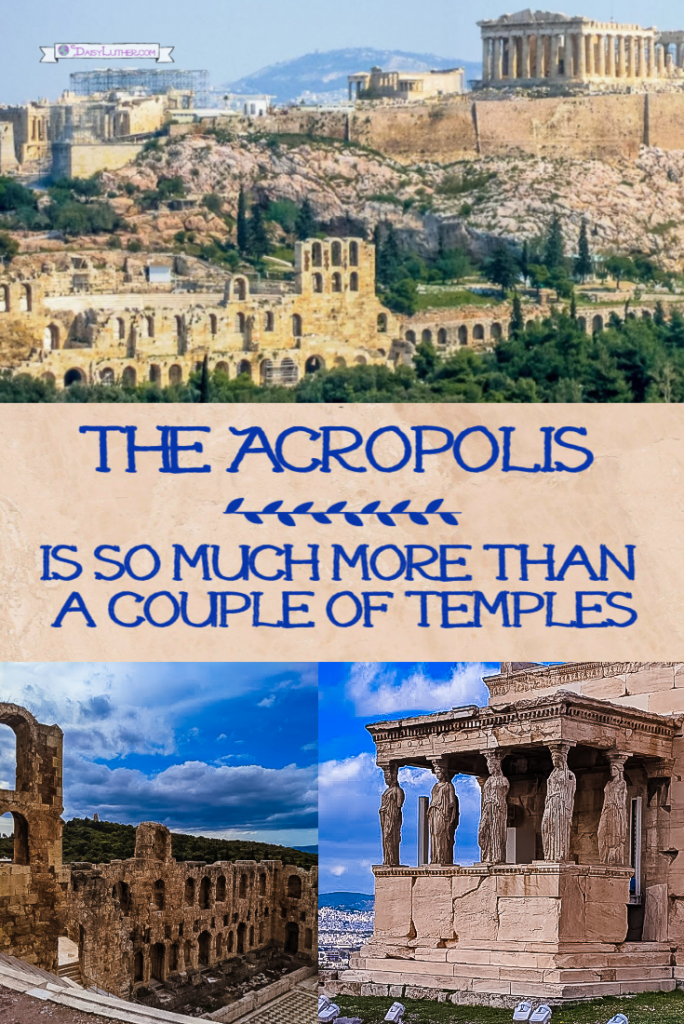The Acropolis Is So Much More Than a Couple of Temples
Nothing says Athens like the Acropolis. You can see the iconic temples from almost everywhere in the city and the sacred mountaintop is a symbol of Athens itself.
This was one excursion I was excited to go on, and it greatly exceeded my expectations. I thought I’d just walk up a steep hill, hyperventilate because I was out of shape, get to the top, take a couple of photos, then hike back down, quads burning.
But it was nothing like that. There was much more to the site than I had imagined. This was a sacred place, and because of that, things were built around it like stoas for government, theaters, and religious structures. There were also more temples at the top than just the Parthenon. I spent about 3 hours visiting the site.
The climb
Once you pay to enter, there’s a sheltered area with lots of statues and partial statues that were found on the site. It rained when I first arrived and this was a great place to get in out of the downpour.
Interestingly, every historical place I visited in Athens has piles and piles of relics and remnants that have not yet been reassembled and the Acropolis was no different. There were quite a few areas roped off that had bits and pieces of ancient stone structures.
On the way up were two theaters. First was the Theater of Dionysus Eleuthereus. It’s thought to be the oldest theater in the world. It dates back to the 4th Century BC. If you look closely, you can see a few seats for important people that have backs. Apparently the acoustics there at the foot of the Acropolis are incredible. The other theater is called the Odeon of Herodes Atticus. It was built more recently than the Theater of Dionysus, in 161 AD. Its made of marble.
The arched openings are the Stoa of Eumenes, a promenade. The cave seen in another photo is thought to have been a Christian Church. I also snapped a photo of a gorgeous cat – there are lots of strays that live at the Acropolis but they’re extremely well-cared for and as you can see in the pictures, they’re not going without.
If you’re not in great shape, you can take your time going up. Stop and take some photos of the spectacular views as you work your way up.
On the way back down, you’ll pass some stone structures that are believed to have been old Christian chapels. And of course, more chunky cats. If you turn and glance back up, you’ll have a lovely view of the Temple of Athena.
Once you’re at the top, you have the awe-inspiring privilege of walking through a massive structure called the Propylaea. I found the uneven columns interesting, and it gives a hint as to how the buildings were constructed.
The view from the top of the Acropolis will make you feel like you’re on top of the world. The city of Athens spreads out below you and you can even catch a glimpse of the Aegean Sea in the distance. There are more “bits and pieces” piled up at the top to be assembled later.
The Parthenon is under renovations but awe-inspiring nonetheless. History nerd that I am, the Parthenon was built to honor Athens and commissioned by Pericles around 440 BC. It’s positively enormous. Just walking up the hill without carrying stuff was a decent hike. Can you imagine the labor to build these masterpieces?
Another temple was the Erechtheion, which was dedicated to Athens, Poseidon, and Erechtonius. It has three parts: the main Temple and two porches. On the side of the Erechtheion was the porch of maidens. The figures are also called caryatids. These intricate figures are actually casts of the originals, several of which are displayed inside the museum. I was told by a local that centuries ago, several of the maidens were taken to England, where they are now in a museum. He said that Greece wants the caryatids back but the two countries have been unable to reach an agreement.
There is also a museum at the top, but I went on a Sunday and it was closed. Here are some photos from the top of the Acropolis.
What you should know about the Acropolis
Here are the answers to the most commonly asked questions about visiting the Acropolis.
How physically challenging is visiting the Acropolis?
Compared to most other sites in Athens, the Acropolis is one of the more challenging ones for people who are out-of-shape. But don’t let this dissuade you from visiting. Yes, there’s quite a climb, but most of it is not exceptionally steep – it’s more of a gradual slope. You may still feel a little bit winded, but there are plenty of places to stop. When you stop, act like you’re taking in the view or examining something a bit more closely – nobody will think anything of it.
Once you are at the top, you should note that the surface is not at all smooth. It’s rough, rocky, and uneven – a twisted ankle waiting to happen to those who don’t wear the right shoes. Leave the flip-flops at home and wear something more sturdy, like hiking or athletic shoes.
If you have a more significant handicap, you could find this trip more difficult. But there is a well-hidden elevator and chair lift on one side of the Acropolis. This website offers a thorough review of the access for disabled people.
What’s the bathroom sitch?
There are bathrooms at the top of the Acropolis.
Is there food?
There is no place that sells food or drinks at this site. Particularly if you go during hot weather, you’re going to want to have a bottle of water with you.
Is there anything tourists should be warned about in the Acropolis?
The Acropolis is very safe as far as threats from pickpockets, etc. The only thing you might worry about is the climb or the rough terrain.
How expensive is the Acropolis?
Admission to the Acropolis is 12 Euros for adults and 6 Euros for children.
Have you been to the Acropolis?
If you’ve been to the Acropolis, how did you like it? What stood out in your mind the most? Do you have any questions about visiting the Acropolis? Let’s discuss it in the comments.




